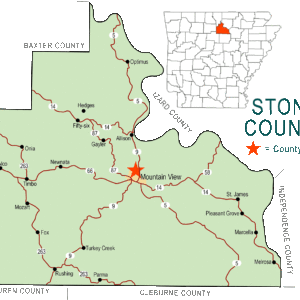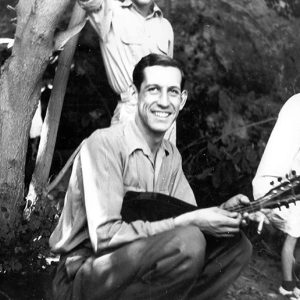calsfoundation@cals.org
Optimus (Stone County)
Optimus is an unincorporated Stone County community in Optimus Township on Highway 5 across the White River from Calico Rock (Izard County), which is five miles to the north. Optimus is about twelve miles north of Mountain View (Stone County), the county seat, and about twelve miles west of Melbourne (Izard County).
Bannerstones (stone artifacts whose function is much debated) have been found at Optimus, indicating early habitation by Native Americans in the caves and bluffs of the area. One of these caves, the Clay Cave, is easily accessible from Sylamore Road.
Miles Ware Jeffery was born in 1816 in what is today Mount Olive (Izard County), three and a half miles south-southeast of present-day Optimus. His parents, Johoiada Jeffery and Mary Ware “Polly” Jeffery, arrived in about 1813 along with their own parents, James “Old Jim” Jeffery and Dr. Jane Mason Jeffery. The original Jeffery homestead and cemetery are in Mount Olive. Dr. Jane Jeffery practiced medicine in the area at a time when women physicians were virtually unknown, although some question if she had the official medical credentials.
The Talburt (a.k.a. Talbert) family of Optimus had deep roots in northern Arkansas going back to at least the 1820s, when Frederick Talburt and his two brothers, Walter and Samuel, blazed a trail to the Arkansas wilderness and befriended Native Americans there. By the 1830s, they were operating a ferry (Talburt’s/Talbert’s Ferry) across the White River, the oldest on the river above the mouth of the Buffalo River. In 1837, the ferry was sold to Jesse Goodman, a keelboatman who had a trading post on the site. The Cherokee are said to have used the ferry on their trek westward to Indian Territory (present-day Oklahoma), as the Talburt Ferry did not discriminate against them and charge them high tolls. The Talburt family later had a ferry at Calico Rock. Another ferry, the Sylamore Ferry on White River, was near Optimus. The Talburt family also built and operated a successful lumber mill in Optimus.
Steamboat travel on the upper White River, north-northwest of Jacksonport (Jackson County), began in 1831 when the Waverly journeyed upstream to Batesville (Independence County). As it was located near the White River, the Optimus area benefited from the steamboat traffic.
The community of Optimus took shape following the Civil War when the Cartwright, Franks, Tipton, Wallace, Sexton, Sneathern, and Tunnicliff families were among the farmers who migrated to this region of the state. These family names can be found on the markers in the Optimus Cemetery. The Optimus Post Office was established in 1888 with James N. Craig appointed first postmaster. According to local historian Martin M. Martin, when locals were deciding on a name for the community, someone suggested Optimus, after the Optimus tomato, which was popular and grown widely in the area. The United States Postal Service accepted the recommendation. However, some in the community maintain that the tomato was named for the settlement. The post office closed in 1955.
The railroad brought prosperity to Optimus at the turn of the twentieth century. The St. Louis, Iron Mountain and Southern Railway was completed from Batesville to Cotter (Baxter County), following the north bank of the White River, by the fall of 1903, and daily passenger service from Newport (Jackson County) to Batesville and on to Cotter was available. The tracks were extended to Carthage, Missouri, by 1906.
The Missouri Pacific Railroad Depot is a historic train station building on Old Arkansas Highway 9 at Sylamore (Izard County) near Optimus; it was added to the National Register of Historic Places on December 1, 2004. Built in about 1902 when the railroad was constructed through the area, it served as a passenger depot until service was ended in 1960. The structure has since been destroyed. There is also a depot in Calico Rock.
The main cemetery for the community is the Optimus Cemetery, once known as the Forrest Hill Cemetery. A prominent figure buried in the cemetery is Dr. Robert Love “Doc” Fleming, a frontier physician.
Optimus Access (a.k.a. Optimus/Boswell Shoals Access), sometimes called Bull Shoals Tailwater, is on the west side of the White River. The access is through the Ozark National Forest. Although the road at the end is maintained by the U.S. Forest Service, the bluff curve on the road can be hazardous depending on road conditions. A popular campground for hunters in the fall, the landing is used to launch small boats, canoes, and kayaks. There is a trail up and down the river at this location.
Maud Dickerson Brooke Buckingham Douglass, who spent part of her childhood at Buford (Baxter County), became a Mennonite while caring for her ailing husband in the Mennonite Sanitarium in La Junta, Colorado. Following his death, she joined the Mennonite church and completed nurses’ training. She is said to have been the first registered nurse in Baxter County. She returned to Baxter County in 1932, helping start a church at Culp (Baxter County) near Calico Rock, called the Bethel Springs Mennonite Church. The church membership increased rapidly. By 1953, there were eighty-eight members. A church school was added in 1935, which had become a grade school and high school with five teachers by 1953. Two more churches were built besides the one at Culp—one southwest of Mountain Home (Baxter County) and one called Mount Joy in the neighborhood of Optimus southeast of Culp.
The Optimus School was established by the early 1900s. In 1949, under Arkansas Act No. 1, a new district was formed called Stone County School District No. 1, which included all school districts in the county except for Mountain View. A county superintendent began overseeing the newly formed Rural Special (at Fox), Timbo, Fifty-Six, and Pleasant Grove school centers. Many of the children of Optimus attended the school at Fifty-Six; the rest went to Calico Rock.
The area surrounding Optimus remains somewhat of a wilderness region, but being near Blanchard Caverns, the Ozark Folk Center, and Mountain View, the community benefits from tourism and its location near the White River. The Miles Jeffery Barn, a rectangular three-saddle-notched log crib structure, is located on private property off Arkansas Highway 5 at Optimus just east of Livingston Creek. The ridge of the barn runs approximately northeast to southwest and is set on stacked stone piers. The oldest crib, at the northeast end, is estimated to date to 1858. The barn was placed on the National Register of Historic Places on September 17, 1985. The Sylamore swinging bridge, located at nearby Allison (Stone County), was originally built in 1914 and has been rebuilt and refurbished a few times since; it continues to be a major tourist attraction. It was added to the National Register of Historic Places on November 18, 1999.
For additional information:
Adams, Walter M. The White River Railway, Being a History of the White River Division of the Missouri Pacific Railroad Company, 1901–1905. North Little Rock, AR: Walter M. Adams, 1991.
Huddleston, Duane, Sammie Cantrell Rose, and Pat Wood. Steamboats and Ferries on the White River: A Heritage Revisited. Fayetteville: University of Arkansas Press, 1998.
“Maude Ethel Douglass, Obituary.” Mennonite Weekly Review, July 24, 1986.
“The Timber Industry in Stone County,” Heritage of Stone 39, no. 2 (2015): 65.
Wolf, John Quincy. Life in the Leatherwoods. Memphis: Memphis State University Press, 1974.
Kenneth Rorie
Van Buren, Arkansas
 Cartwright Children
Cartwright Children  Optimus Cemetery
Optimus Cemetery  Optimus
Optimus  Optimus School Students
Optimus School Students  Railroad Workers
Railroad Workers  Stone County Map
Stone County Map  Sylamore Creek Bridge
Sylamore Creek Bridge  Talburt Ferry
Talburt Ferry  Talburt Home
Talburt Home  Ed Talburt
Ed Talburt  Eugene Talburt
Eugene Talburt 




Comments
No comments on this entry yet.